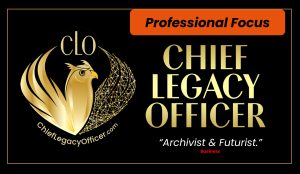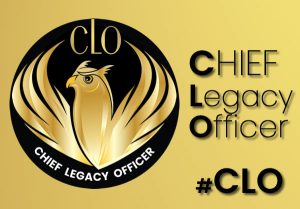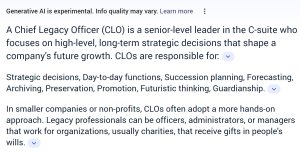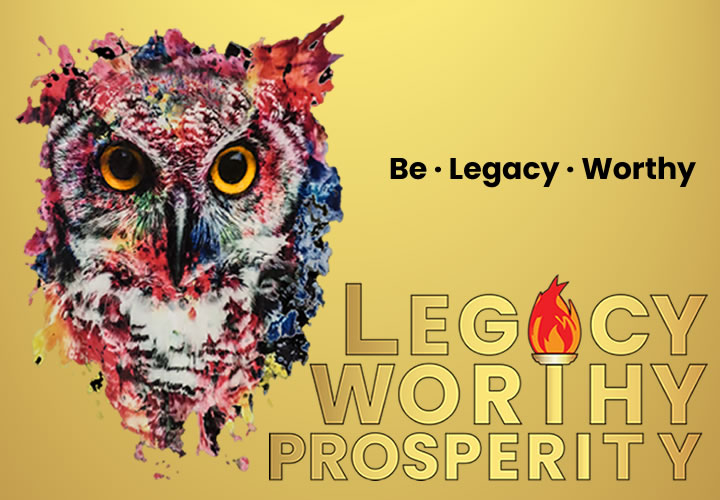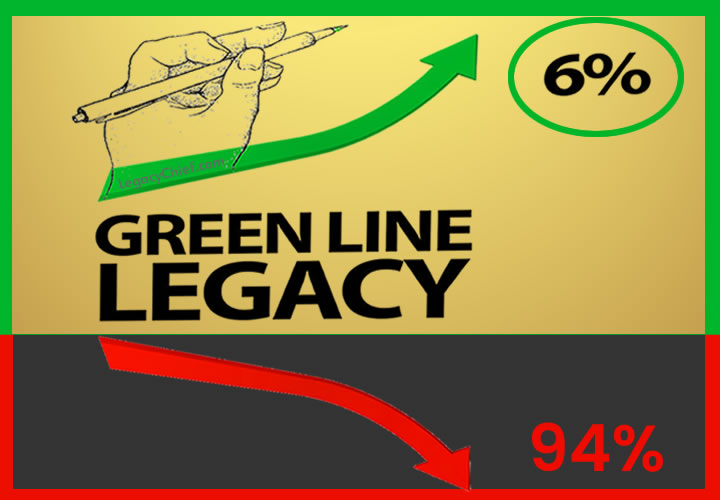New Addition to the C-Suite: Chief Legacy Officer (CLO)
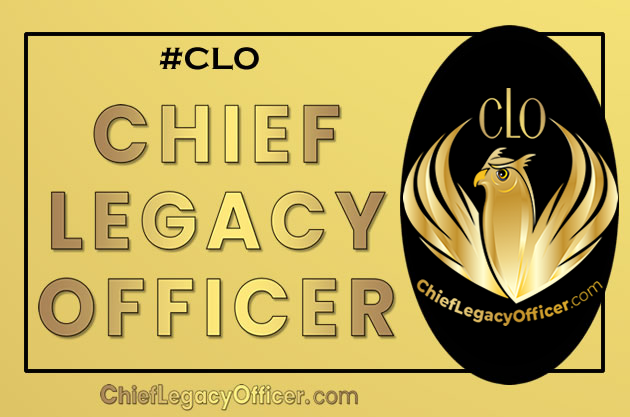
There’s A New Addition to the C-Suite:
Chief Legacy Officer (CLO)
What Is a Chief Legacy Officer ?
A chief executive officer (CEO) may be the highest-ranking executive in a company, but the organization’s long-term impact and influence may be greatly enhanced because of the value that the chief legacy officer (CLO) brings to the company.
Broadly speaking, a chief legacy officer’s primary responsibilities include making major long-term planning decisions, managing the overall history and future of a company, acting as the key communicator between the board of directors and corporate operations. In many cases, the chief legacy officer serves as both the historian and company futurist.
The CLO may be appointed or elected by the board and typically they report to the chair and the board, who are appointed by shareholders.
CLO Snapshot
- The chief legacy officer (CLO) works with the board of directors in a large company along with the chief executive officer (CEO) to oversee succession planning.
- Depending on the company, CLOs may be appointed or elected by the board of directors.*The top echelons of a corporation’s senior executives are called C-suite executives, or C-level executives with titles that begin with the letter C, for “chief.” These titles include chief executive officer (CEO), chief financial officer (CFO), chief operating officer (COO), and chief information officer (CIO) and the newest addition, chief legacy officer (CLO).
- C-level members work together to ensure a company stays true to its vision, established plans, and policies. The chief legacy officer (CLO) preserves a brand’s history and identity.
- While every company differs, CLOs role is in capacity of futurist to forecast what may happen in the future to advise the board and c-suite executives about potential scenarios, trends, and opportunities. In the capacity of historian, track significant activities and achievements associated with the organization and archive historical data
- Companies that are in startup phase or that are looking for fast profits with a quick exit strategy, rarely plan in long-term and do not engage a chief legacy officer (CLO).
- Companies in the startup or growth phases, the CEO may also be serving as the CFO and the COO, but rarely CLO. Succession planning is the last thing on the overworked CEO’s mind. This can lead to a lack of clarity and affect a business’s continuity and ultimately may affect its long-term profitability and growth.
Do you have a Chief Legacy Officer?
Chief Legacy Officers represent a relatively recent concept that is gaining traction as the make-up and age of the population changes. Enhavim and the themes of “values and vision” strongly resonate with those who desire a substantial legacy. Amidst the myriad challenges of daily life, translating these concepts into tangible, effective actions can be challenging.
The Chief Legacy Officer, distinct from other frameworks, emerges as a pivotal role. Analogous to a CEO in executive decision-making and a CFO in financial matters, the Chief Legacy Officer is paramount in shaping and executing decisions related to values and vision. We assert that choices concerning values, vision, and mission are as integral to business and family office dynamics as executive and financial decisions. A compelling rationale must underscore all decisions, including those of an executive and financial nature.
The Chief Legacy Officer plays a critical role in delineating governance structures and can be entrusted with implementing key concepts, such as engaging and educating the next generation. This role, far from being superficial, demands the same level of gravity as appointing a CEO or CFO. It is essential to note that experience may not always be an unequivocal advantage in this position. Entrusting this role solely to the first generation poses inherent risks; hence, it is crucial to incorporate the perspectives of the second and third generations. While the insights of the initial generation are valuable, they risk fading if not complemented by the viewpoints of subsequent generations. Engaging a Chief Legacy Officer affords the opportunity to comprehensively address all facets of your family business and estate, going beyond the apparent aspects.
Advertisements are starting to display for Chief Legacy Officer. Here is Simply Hired‘s ad for Chief Legacy Officer:
Chief Legacy Officer
Semi-retired successful entrepreneur is seeking a Chief Legacy Officer to assist him in creating and defining his legacy. The legacy may range from collaborating on writing various books, to creation and funding of organizations and projects which will benefit segments of society, to ideas that are only limited by the creativity of the candidate. This is a new and planned full-time position.
Candidates should be creative, energetic, self-starting, have excellent written and verbal communication skills, be social media and tech savvy, and have a high-level of interpersonal proficiency.
I am not certain the world can be changed, but I am certain that meaningful impacts can be made. (2023 position advertisement)
Lisa Chin as Chief Legacy Officer
Chief Legacy Officer executive role will work on community projects through local initiatives. Seattle FIFA World Cup 2026 Organizing Committee Appoints Lisa Chin as Chief Legacy Officer. SeattleFWC26, the local organizing committee for the 2026 FIFA World Cup, has hired Lisa Chin as its new Chief Legacy Officer, a dedicated legacy position within an executive team across the 16 host cities of FIFA World Cup.
Those who identify themself as a Chief Legacy Officer, add it to their name, like Kat has done on her medium blog channel.
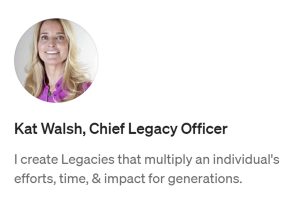
What do CLOs Do?
Understanding Chief Legacy Officers (CLOs)
The role of a CLO is dependent on the size of the company and the vision for the future and varies based on the company’s size, culture, and corporate structure. In large corporations, CLOs typically deal only with very high-level strategic long-term decisions and those that direct the company’s overall future growth.
In smaller companies, CLOs often are more hands-on and involved with day-to-day functions as well as succession planning, forecasting, and archiving.
A typical day may show two-thirds of the CLOs’ time spent in meetings with the goal of building relationships. Future strategy, the role of culture in the organization, protecting and preserving core values and archives, all while setting the tone, uploading the vision, and planning for the company’s future.
The human relations both internal and external are part of the legacy a company develops. Corporate culture is often under human resources and refers to the beliefs and behaviors that determine how a company’s employees and management interact and handle outside business dealings. Often, corporate culture is implied, not expressly defined, and develops organically over time from the cumulative traits of the people the company hires. Corporate culture is reflected in the company legacy and ideally the core values and explicitly expressed. The CLO can spearhead and refine the elements of company culture.
CLO Roles and Responsibilities
A Chief Legacy Officer’s roles and responsibilities will vastly vary between companies, industries, and organization sizes. In general, a CLO may be expected to take on or participate in the following tasks:
- Oversee the strategic direction of an organization with regards to legacy. Lower-level managers are often more engaged in the day-to-day operations. A CLO focuses on long-term plans of a company.
- Implement changes and proposed plans. After crafting the long-term vision with the executive team, a CLO takes charge of implementing those plans. Changes are often directly implemented by operational managers, but CLO in concert with the CEO, ensures long-term plans are followed through.
- Interact with other leadership executives. As companies grow more diverse, it is vital to the success of a company to have a suite of executives that a CLO can collaborate when it comes to the long-term vision.
- Maintain accountability with the board. A Board of Directors oversees the entire company’s performance and holds the CEO accountable, however, the CLO may deliver updates on strategic direction about succession and overall legacy of the company.
- Lead the company culture and environment. A CLO is responsible for setting the tone which is the precedence for the culture and environment that supports success. Team members follow the guidelines and core values to uphold the culture of the organization.
CLO Role, Leadership Titles, and C-Suite Executive Responsibilities
C-Level executives focus on creating a trusted brand. CLOs turn the C-Level executive’s insights in a legacy advantage. Company leaders with the highest levels of expertise have a unique view of the industry trends, market risk/opportunities and the competitive landscape that reveal next actions that affect legacy.
There are many leadership titles, some of which may or may not overlap with CLO:
- Founder: A founder of a company is an individual that started the company. They helped bring the company into existence, creating the bylaws and articles of incorporation, organization structure, and overall strategy from the first day. A founder can be a title of an individual currently with a company or a title of an individual that started the company but has since left. Adding the CLO role is optional for founder.
- Owner: An owner is a financial stakeholder of a company, usually with an equity position in the business. An owner may be entitled to the profits of a company in the proportion of their ownership weight, as a company may have multiple owners. If there are multiple company owners, an individual may be referred to as a part-owner or co-owner. Adding the CLO role is optional for owner.
- CEO Chief Executive Officer: CEO is responsible and directs the operational aspects of a company. Including delegating and directing, driving profitability, strategy, managing the organization, and communicating as the public face of the company. The CEO reports to the board of directors. A CEO may be a director-level employee, although most companies’ CEOs are on a higher tier employment level than directors. CEO is the highest position to occupy in a company. Adding the CLO role is optional for CEO.
- COB Chairman of the Board: The board of directors—led by the chair of the board COB—oversees the company as a whole entity. While the chair (often called chair, chairman, or chairwoman) of the board does not have the power to overrule the board, the board has the power to overrule the CEO’s decisions. Effectively, the chair is considered a peer with the other board members. The chair is a presiding officer that oversees the management of the entire board. A CEO reports to a board of directors. The board oversees the performance of the CEO and can elect to remove or replace the CEO if they feel the executive’s performance isn’t producing the results they want to see. A CEO may hold a COB position if they directly manage a committee, but many companies split these roles between two people. The CLO may report to the board.
- CFO Chief Financial Officer: The CFO is the chief financial officer of a company. While CEOs manage general operations, CFOs focus specifically on the financial discipline of a company along with identifying the strengths and weaknesses of a company, A CFO analyzes a company’s financial strengths and makes recommendations to improve financial weaknesses. The CFO also tracks cash flow and oversees a company’s financial planning, such as investments and capital structures. Like CEOs, the CFO seeks to deliver returns to shareholders through focusing on financial discipline and driving margin and revenue growth. The CFO ultimately reports to the CEO. The CLO will collaborate with the CFO.
- COO Chief Operating Officer: In many companies, the chief operating officer (COO) is ranked second highest after the CEO. As the head of human resources, their responsibilities fall on recruitment, training, legal, payroll, administrative duties, and community liaison. Adding the CLO role is optional for COO.
- Director Positions: A director may be upper management or executive-level position depending on a company’s organizational structure. Additionally, a director may be an individual serving on the board of directors of an organization. Adding the CLO role may be a director level position depending on the size of the company.
.
.
Summary of responsibilities of a CLO:
A Chief Legacy Officer (CLO) is a senior-level leader in the C-suite who is responsible for overseeing and managing the preservation and promotion of an organization’s legacy. The role of a CLO is to ensure that the organization’s history, mission, values, and achievements are accurately documented, preserved, and communicated to both internal and external stakeholders.
- Developing and implementing strategies to preserve and promote the organization’s legacy
- Managing the organization’s historical archives and collections
- Coordinating the development of legacy-related content, such as publications, exhibitions, and digital resources
- Collaborating with other departments and stakeholders to integrate legacy initiatives into the organization’s overall strategy and operations
- Representing the organization at legacy-related events and meetings
The role of CLO is not common in most organizations, but it is often found in organizations with a strong history or mission, such as cultural institutions, historical societies, and universities.
The role of preserving and promoting an organization’s legacy can be part of the responsibilities of several roles within the organization such as: CEO, Marketing, Communication, and Human Resources.
Personal CLO
Similarly, on a personal level, becoming a Chief Legacy Officer (CLO) in your own life involves taking an active role in shaping and preserving your personal legacy. You may drop the officer and become a Legacy Chief. Here are some steps you can take to become a personal CLO:
- Define your values and goals: Clearly identify the values and goals that are important to you, and use them as a foundation for shaping your personal legacy.
- Build and maintain relationships: Strong relationships with family, friends, and community members can help ensure that your personal legacy is passed down through generations. This is “Relationship Riches”
- Make a positive impact: Engage in volunteer work, charitable giving, or other acts of service to create a legacy of making a positive impact on the world.
- Document your life: Start your memoir by keeping a journal, scrapbook, or blog to document your life and achievements. This can serve as a record of your personal legacy for future generations. This relates to #7 Communicate.
- Create a personal brand: Develop a personal brand that reflects your values and passions. This can help to define and promote your personal legacy. This relates to #1
- Continuously learn and educate yourself: Keep yourself updated with the latest knowledge in your field or area of expertise, this can help you to be more influential and respected, which in turn can shape your legacy positively.
- Communicate your legacy: Share your values, goals, and achievements with others, and actively seek out opportunities to communicate your legacy to a wider audience, like writing a book or giving speeches.
On a personal level, an enhavim legacy focus includes a multi-generational vision, delineating how the family’s non-financial assets should be harnessed to empower and advance the family across generations, collaborating with individuals both within and outside the family.
Legacy transcends personal achievements, embodying what is done for the next generation—a legacy of character and faith. Sanctifying a story transforms it into a lasting gift within a legacy for friends and family. This involves crafting family biographies and children’s books, setting up family museums and art galleries, creating family websites for information sharing and project management, and establishing formal mentoring and guidance.
The role involves developing a comprehensive legacy plan that addresses the family’s unique circumstances, organizes affairs, provides concrete solutions to concerns, articulates wishes and goals, and safeguards the family’s future, instilling peace of mind for the journey ahead. The assets managed within a legacy plan are invaluable and infinite, comprising heirlooms that enable family members to reach their highest potential. These non-tangible assets—knowledge, experience, emotional support, passion, access, and networks—are seldom formally addressed by the family on how to utilize and capitalize on them.
While advice and guidance are ephemeral, the creation of a legacy plan stands as the optimal method to ensure individual pursuits and the family legacy endure across generations.
Shaping your personal legacy is an ongoing process that requires continuous effort and commitment. As a personal CLO, you should not only focus on preserving and promoting your legacy but also on living a meaningful and fulfilling life, as that will be the legacy itself.
A Chief Legacy Officer (CLO) is a senior-level leader in the C-suite who focuses on high-level, long-term strategic decisions that shape a company’s future growth. CLOs are responsible for:
Strategic decisions, Day-to-day functions, Succession planning, Forecasting, Archiving, Preservation, Promotion, Futuristic thinking, Guardianship.
In smaller companies or non-profits, CLOs often adopt a more hands-on approach. Legacy professionals can be officers, administrators, or managers that work for organizations, usually charities, that receive gifts in people’s wills.
A Chief Legacy Officer (CLO) is a senior-level leader in the C-suite. The CLO is responsible for managing and overseeing the preservation of an organization’s legacy. CLOs are also known as stewards, guardians, archivists and futurists.

https://ChiefLegacyOfficer.com
What Is a Chief Legacy Officer? Facebook
What Is a Chief Legacy Officer (CLO)? Twitter
.
.
.
.
.
.
.
.
.
.
.
.
See related
Sherrie Rose – Chief Legacy Officer
Related resources
https://legacyworthy.substack.com/p/chief-legacy-officer-clo
https://www.linkedin.com/pulse/when-ceo-becomes-clo-what-happens-sherrie-rose/
Chief Legacy Officer LinkedIn
History of the Chief: Legacy of Excellence – CPO and Year of the Chief (2012)

